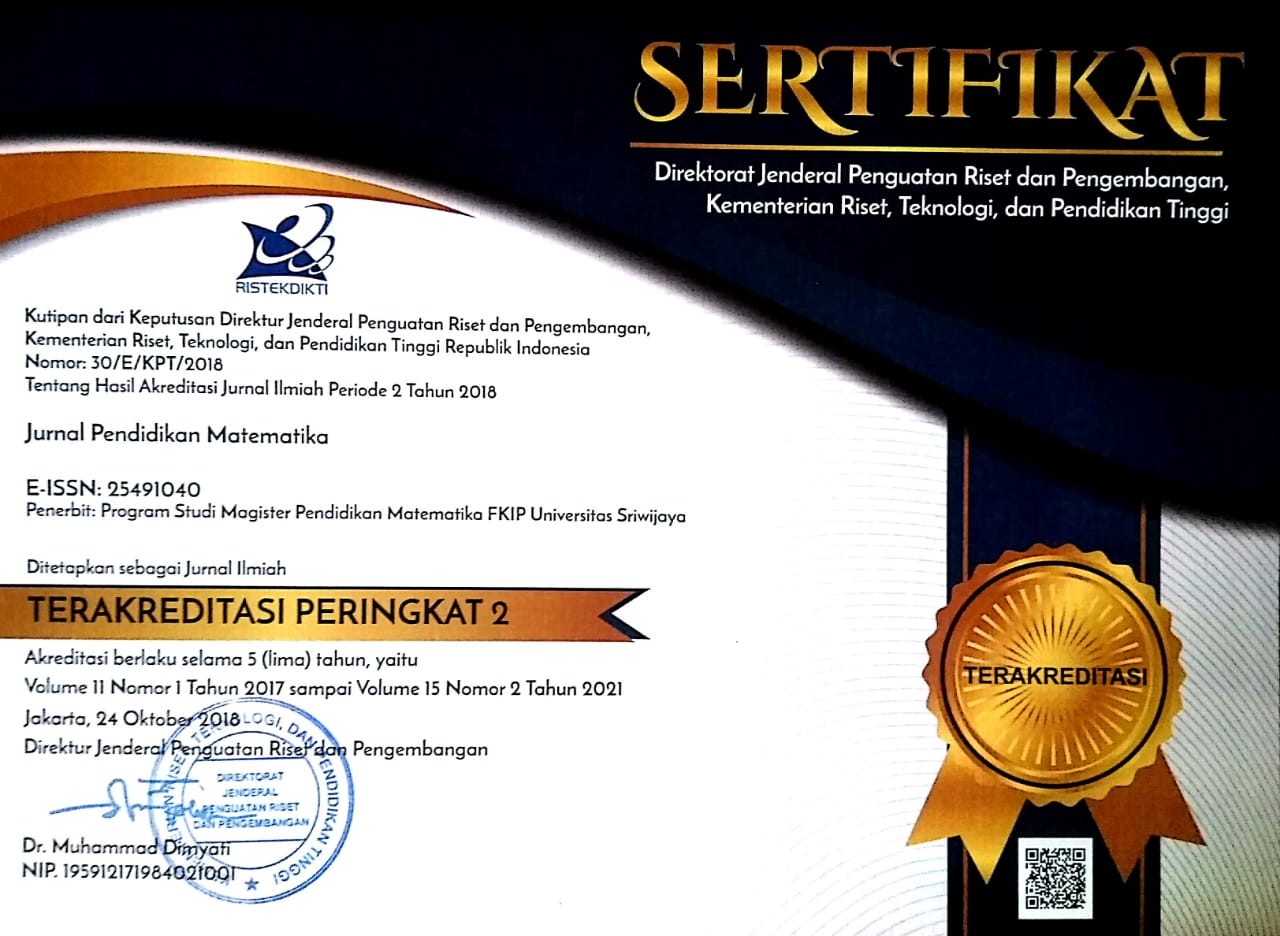ANALISIS KONSEPSI GURU-GURU MATEMATIKA SEKOLAH MENENGAH TENTANG HAKIKAT MASALAH MATEMATIKA DALAM PENDEKATAN STUDENTS CENTERED LEARNING (STUDI KASUS DALAM PEMBELAJARAN MATEMATIKA DI SMA KOTA PALEMBANG)
Abstract
Keywords
Full Text:
PDFReferences
Ardhana, W., Kaluge, L. & P. (2005). Pembelajaran inovatif untuk pemahaman dalam belajar matematika dan sains di SD, SLTP, dan di SMU. Ditjen Dikti: Depdiknas.
Barkatsas, A.T. & Malone, J. (2005). A typology of mathematics teachers’ beliefs about teaching and learning mathematics and instructional practises. Mathematics Education Research Journal, 17 (2), 69-90.
Baroody, A.J. (1993). problem solving, reasoning and communicating, K-8 (helping children think mathematically). New York: Macmillan Publishing Company.
Charles, R. & Lester, F. (1982). Teaching rroblem solving: What, why, and how. Palo Alto, Calif: Dale Seymor Publications.
Collins, J. W., & O’Brien, N. P. (2003). Greenwood dictionary of education. Eds. Westport, CT: Greenwood.
Cooper, P. a. (1993). Paradigm shifts in designed instruction-from behaviorism to cognitivism to constructivism. Educational technology.
Creswell, J.W. (1994). Research design, qualitative & quantitative approaches. Thousand Oaks: Sage.
Darsono, D. K.K.,(2000). Belajar dan pembelajaran. Semarang: IKIP Semarang Press.
Day, R. (1996). Case studies of preservice secondary mathematics teachers’ belief: Emerging and envolving themes. Mathematics Education Research Journal, 8 (1), 5-22.
Dossey, J. (1992). The nature of mathematics: It’s role and its influence. In D. A. Grouws (Ed.), Handbook of research on mathematics teaching and learning (pp. 39-48). New York: Macmillan.
Ernest, P. (1988). The impact of beliefs on the teaching of mathematics. In P. Ernest (Ed.), Mathematics teaching: The State of the art. London: Falmer. Hamalik, O. (2008). Kurikulum dan Pembelajaran. Jakarta: Bumi Aksara.
Harmon & Harumi. (1996). School improvement in an era of change. London; Cassell.
Hassoubah, Izhab Zaleha. (2004). Developing creatif and critical thinking skill (Cara berpikir kreatif dan kritis). Nuansa: Bandung.
Hudoyo, H (1979). Pengembangan kurikulum matematika dan perlaksanaan di depan kelas. Surabaya: Usaha Nasional.
Johnson, B. & Christensen, L. (2000). Educational research. Boston: Allyn and Bacon.
Kemdikbud. (2013). Peraturan Menteri Pendidikan dan Kebudayaan Republik Indonesia Nomor 81A Tahun 2013 tentang Standar Nasional Pendidikan. Jakarta: Kemdikbud.
Khun, T. S. (1993). Peran paradigma dalam revolusi sains. Jakarta: Rosda Karya.
Kuhs, T., & Ball, D. (1986). Approaches to teaching mathematics: Mapping the Domains of Knowledge, Skills and Disposition (Research Memo). Lansing, Mi: Michigan State Unversity
Land, S.M. & Hannafin, M. J. (2000). Studentcentered-learning environments. Mahwah, New Jersey: Lawrence Erlbaum Associates.
Lea, S. J., Stephenson, D. & Troy, J. (2003). Higher education students’ attitudes to student-centred learning: Beyond “educational bulimia”. Studies in Higher Education, 28 (3), 321–334.
Lebar, O. (2015). Penyelidikan Kualitatif. Malaysia: Linemax Media SDN BHD.
Liljedahl, P. (2008). Teachers’ beliefs as teachers’ knowledge. In Symposium on the Occasion of the 100th Anniversary of ICMI. Rome, 5-8 March 2008.
Lincoln, Y., & Guba, E. (1985). Naturalistic inquiry. New York: Sage.
Lubinski, D. & Dawis, R.V. (1995). Assessing individual differences in human behaviour: New methods, concept, and finding. Plo ato, Ca: Consulting Psychologist press.
Machemer, P. L. & Crawford, P. (2007). ‘Student Perceptions of Active Learning in a Large Cross- Disciplinary Classroom’, Active Learning in Higher Education, 8(1), pp. 9–30. doi: 10.1177/1469787407074008.
Maxwell, J.A. (1996). Qualitative research design: An interactive approach. Thousand Oaks: Sage.
Merriam, S.B. (2001). Qualitative research and case study applications in education. San Francisco: Jossey-Bass Pub.
Miles, M. B. & Huberman, A. M. (2014). Qualitative data analysis (2nd. ed). Thousand Oaks: Sage Publications.
Moleong, L. J. (2006). Metode penelitian kualitatif. Bandung: Remaja Rosda Karya.
Mulyana, E. (2009). Pengaruh Model Pembelajaran Matematika Knisley Terhadap Peningkatan Pemahaman dan Disposisi Matematis Siswa SMA Program IPA. Bandung: Disertasi, Universitas Pendidikan Indonesia.
Natajaya, I.N., Santyasa, I W. & Anggan Suhandana, G. (2008). Pengembangan model pelatihan untuk pembinaan profesi guru dan pengaruhnya terhadap perolehan belajar siswa. Lembaga Penelitian Undiksha.
Novotná, J. et al. (2014). Problem solving in school mathematics based on heuristic strategies. Journal on Efficiency and Responsibility in Education and Science, 7 (1), 1-6. (Online), ISSN 1803- 1617, printed ISSN 2336-2375, doi: 10.7160/eriesj.2013.070101.
Ormrod, J.E. (2000). Educational psychology: Developing learners (7th ed). Upper Saddle River, New Jersey: Merrill. Chapter 1, pages 1-23.
Pardjon. (2000). Konsepsi Guru Tentang. (2), 73–83.
Pedersen, S. & Liu, M. (2003). Teachers' beliefs about issues in the implementation of a student-centered learning environment. Educational Technology Research and Development, 51 (2), 57-76.
Piaget (1983). Piaget’s theory. In P. Mussen (Ed.). Handbook of Child Psychology. New York: Wiley.
Santyasa, I.W. & I.W.S.W. (2014). Analisis kebutuhan pengembangan model-model student-centered learning untuk meningkatkan penalaran dan karakter siswa SMA. Jurnal Pendidikan Indonesia, 3 (1).
Suryadi, D. (2005). Penggunaan Pendekatan Pembelajaran Tidak Langsung serta Pendekatan Gabungan Langsung dan Tidak Langsung dalam Rangka Meningkatkan Kemampuan Berpikir Matematik Tingkat Tinggi Siswa SLTP. Disertasi. Bandung: Universitas Pendidikan Indonesia.
Sutiarso. (2000). Problem Possing: Strategi Efektif Meningkatkan Aktivitas Siswa Dalam Pembelajaran Matematika. Prosiding Konferensi Nasional Matematika X.
Syaban, M. (2009). Menumbuhkembangkan Daya dan Disposisi Matematis Siswa Sekolah Menengah Atas Melalui Pembelajaran Investigasi, Menumbuhkembangkan Daya dan Disposisi Matematis Siswa Sekolah Menengah Atas Melalui Pembelajaran Investigasi, III(2), pp. 129–136.
Tahmir, S. (2008). Model Pembelajaran Resik Sebagai Strategi Mengubah Paradigma Pembelajaran Matematika di SMP yang Teachers Oriented Menjadi Stuudent Oriental. Direktorat Jenderal Pendidikan Tinggi, Depdiknas, 1–35.
Thompson, A.G. (1992). Teachers’ beliefs and conceptions: A synthesis ofthe research. In D. A. Grouws (Ed.), Handbook of Research on Mathematics Teaching and Learning. New York: Macmillan.
Vygotsky, L. (1978). Interaction Between Learning and Development. In M. Gauvain & M. Cole (Eds.). Readings on the Development of Children. New York: Scientific American Books.
Westwood, P. (2008). ‘What Teachers Need to Know about Learning Difficulties’, p. 105. doi: 9780864319364.
DOI: https://doi.org/10.22342/jpm.12.1.5442.79-88
Jl. Srijaya Negara, Bukit Besar
Palembang - 30139 Indonesia
Jurnal Pendidikan Matematika is licensed under a Creative Commons Attribution-NonCommercial-ShareAlike 4.0 International License.
Indexed in:


